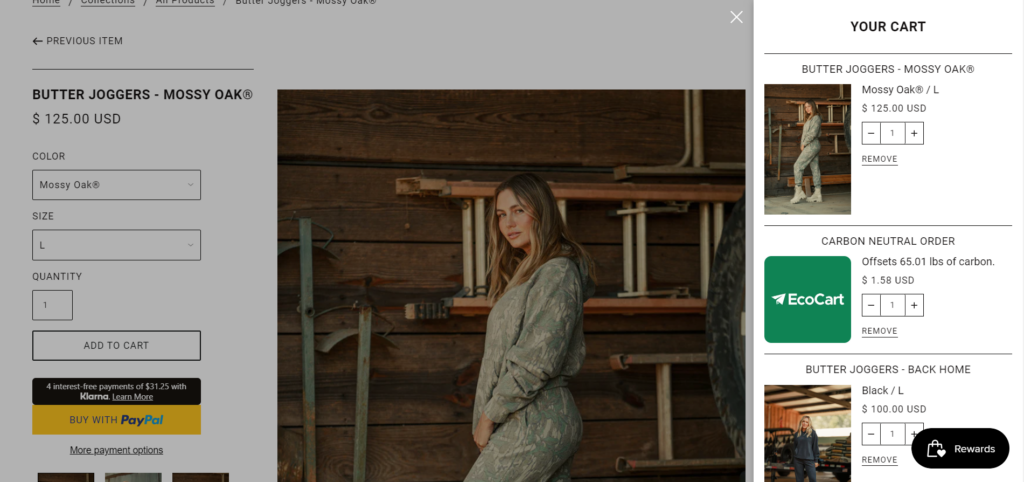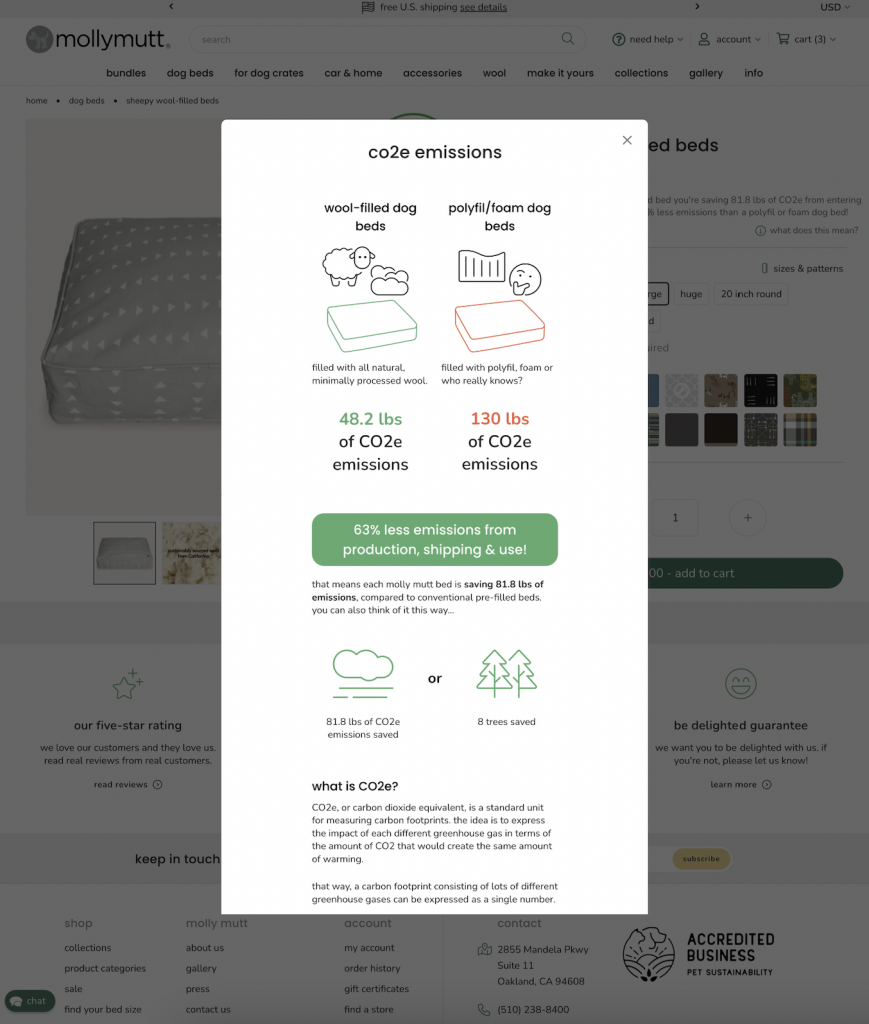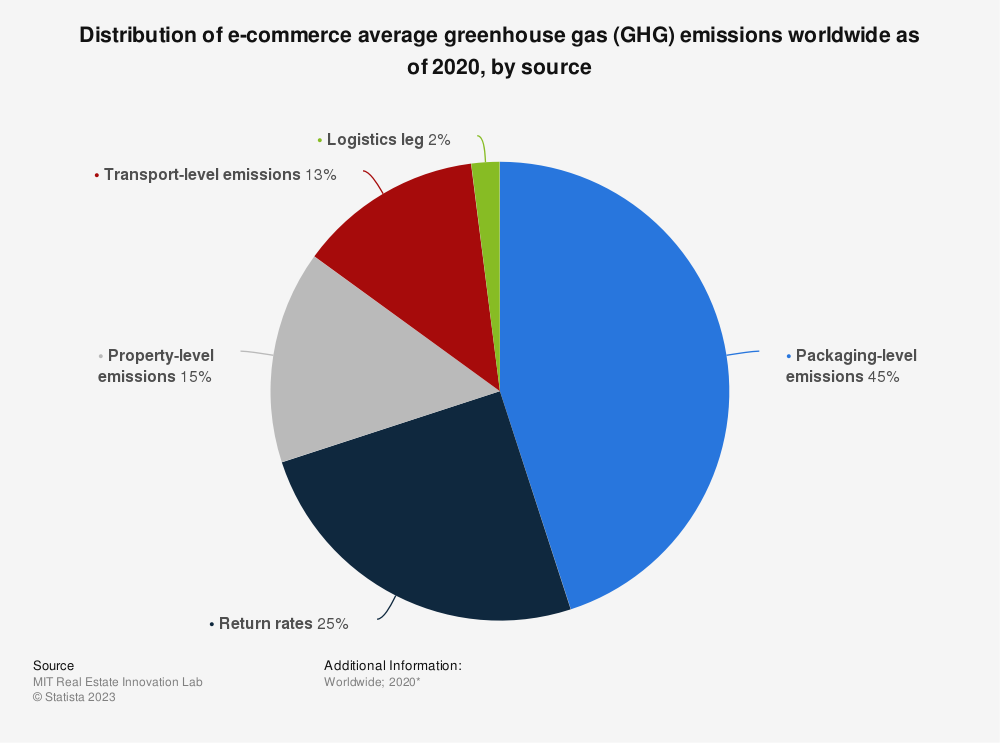To reduce your business’s emissions, you must make science-backed changes that result in meaningful impact. Carbon neutral ecommerce isn’t achieved using lip service. You need to ensure that the strategies you implement are measurable and effective in reducing carbon emissions while still growing your brand. Here’s how to reduce business carbon footprint.
What Is Your Carbon Footprint?
Your carbon footprint is a combined total of the carbon dioxide you release on a daily basis. Everything we do emits carbon, from breathing to browsing the internet, and our footprint measures the total carbon that’s emitted due to our actions.
The carbon footprint associated with ecommerce typically comes from greenhouse gas emissions from shipping and transport as well as the carbon emissions associated with the production of plastic packaging. Other areas where ecommerce companies see their greatest greenhouse gas emissions are in the production of their products, materials used, and the CO2 emissions of their data centers.
In order for ecommerce businesses to reduce their carbon footprints, they must identify their greatest areas of impact and figure out ways to minimize their footprint in those areas. For example, they might reduce their greenhouse gas emissions associated with transport by using suppliers that are located near their warehouses or production centers.
Common Factors That Contribute To Your Carbon Footprint
Within ecommerce, there are a few key areas where you’ll see the highest carbon footprint across sectors. According to MIT Real Estate Innovation Lab, here are the biggest areas of impact.
- Packaging (45%): This refers to the production, use, and disposal of packaging. Plastic packaging often carries high GHG emissions.
- Return rates (25%): This may come from the additional transportation and packaging needed to return an online purchase.
- Property-level emissions (15%): This includes things like energy use, water consumption, paper use, etc.
- Transport-level emissions (13%): This doesn’t just include the emissions associated with shipping. It also covers the use of fossil fuels during transportation of materials to produce the products and moving items between warehouses.
- Logistics leg (2%): This has to do with the carbon emissions of product storage and overall operations.
The Importance Of Reducing The Carbon Footprint Of Ecommerce Businesses
We’ve established what your carbon footprint is. But, are carbon footprints important to ecommerce businesses? The answer is twofold: Reducing your carbon footprint is good for the planet and it’s essential to business.
How reducing your carbon footprint is good for the planet
Climate experts say that if we don’t limit global temperatures to 2ºC below pre-industrial levels, it could result in irreversible damage. The global average temperature has risen rapidly in the last few decades, and we’ve seen the 10 warmest years on record since 2010. It’s clear that major changes need to be made to reduce the global average temperature and keep us from hitting the catastrophic milestone.
In matters such as this, every decision makes a difference. Where a single consumer can opt for a single sustainable product, an ecommerce business can opt to make every product sustainable.
Making simple changes like investing in sustainable packaging, using recycled materials, and offering carbon neutral shipping to customers can have a ripple effect that results in massive impact.
How reducing your carbon footprint is good for your business
Reducing greenhouse gas emissions is as good for businesses as it is for the planet. Modern consumers seek out sustainable companies that align with their values.
In fact, 93% of consumers are already shopping sustainably more and more each year and 75% of consumers will go so far as to disengage from a brand that doesn’t have sustainable operations.
Let’s take a look at some of the biggest ways that reducing your carbon impact can grow your business.
- Improve customer loyalty. Hubspot lists taking a stand as one of today’s biggest marketing trends. This is because companies are seeing a higher conversion rate and more repeat customers when they show that they align with their customers’ values. Their environmental impact is a huge part of this.
- See business growth. According to McKinsey, products that made ESG-related claims saw 28% growth. Products that didn’t only saw 20%.
- Save money. When you choose renewable energy sources, like solar power, you use less energy. Furthermore, energy-efficient LED lights and electricity-saving actions can improve your energy efficiency. It’s a win-win!
- Stay ahead of legislation. As lower greenhouse gas emissions become vital, more and more regulations emerge to limit carbon output. Stay ahead of costly regulations by implementing environmental sustainability strategies now.
- It looks good to investors. When an investor analyzes your company, they’re looking at how you’ll succeed in the long run. Because sustainability strategies improve customer loyalty, save on costs, and ensure that your business stays ahead of ESG legislation, it looks fantastic to potential investors. In fact, McKinsey found that investors love companies that can show a link between their financial performance and ESG efforts.
How To Reduce The Carbon Footprint Of Your Business
To reduce your carbon footprint, it will take a lot of effort in many different places. When developing a sustainability strategy, you must seek to reduce your footprint in all areas of your business. Realistically, you will begin by focusing on one or two of your biggest areas of impact and working from there.
Let’s take a look at some steps that your business can take toward a carbon neutral future.
Step 1: Calculate your carbon footprint
To reduce your footprint, you first need to know exactly what your footprint is. When calculating your carbon footprint, you need to be completely thorough in your analysis.
It’s very possible that you are amassing a footprint in areas you wouldn’t even consider. For example, the CO2 emissions of the internet are surprisingly large. If you have not invested in a green web host, then your website alone may be adding to your footprint. Sustainability management software can help your business keep track of where all of your emissions are coming from.
Here are a few ways to get a clear view of your ecommerce business emissions:
- A product life cycle analysis (LCA) will help you evaluate the entire supply chain as well as end-of-life sustainability of your products.
- A sustainability scorecard will highlight the different areas of your business that have the greatest room for improvement.
- Learn how to calculate your carbon footprint with meaningful results or use the EcoCart Carbon Calculator.
Want a complete evaluation of exactly where your business is emitting the most carbon? Try our sustainability scorecard quiz to get an idea of which areas your business can improve in:
Once you have an idea on where your business can improve, create clear, actionable sustainability KPIs. Once you have these in place, you’ll know exactly which kinds of sustainability initiatives to implement.
Step 2: Develop strategies to reduce your carbon footprint
Start out by focusing on your greatest areas of impact. Within ecommerce, this will likely be your packaging and transportation. Take a look at our guide to sustainability KPIs to see exactly where your business can make the most impactful changes.
Start by making easy changes like investing in eco-friendly packaging and encouraging customers to use standard shipping over fast options. Enlist the help of experts to help develop effective strategies, like improving energy efficiency.
Here are a few ways to get started:
- Use carbon offsetting projects
- Improve the supply chain
- Recycle products
- Use sustainability assessment scorecards
- Track products at the item-specific level
Follow these sustainable business practices for even more ways to reduce your carbon footprint.
Step 3: Offset the parts of your carbon footprint that you can’t reduce (yet)
Depending on your resources, there may be areas where it’s not feasible to reduce your carbon footprint. In these cases, you can invest in verified carbon offset projects to take responsibility for the carbon output that you can’t yet eliminate.
Ecommerce businesses can use a carbon neutral shipping app, for example. Other types of businesses can evaluate their emissions and employ carbon offsetting projects based on the evaluation.
Tribe Kelley uses EcoCart to showcase its carbon positive shipping initiative. Customers can add “carbon neutral order” to their carts, just like any other item.

However, do not use carbon offsets as a crutch. You should always work toward true carbon neutrality, and develop strategies and methods to minimize your carbon footprint as much as possible.
Step 4: Engage your customers
By including your customers in your sustainability goals, you encourage customer loyalty while giving them a warm fuzzy feeling. Being sustainable feels good. Why not share the joy? You can do this by sharing your sustainability stories and making them active participants in your goals through carbon neutral shipping.
Strategies For Reducing Your Brand’s Carbon Footprint
It’s clear that reducing your emissions, and ideally becoming carbon neutral, is essential for your ecommerce business. But, how exactly can you do that?
You cannot make surface-level feel-good changes and claim a small footprint. Not only are customers actively scrutinizing companies for greenwashing, but unsubstantial carbon reduction strategies result in zero environmental benefits and, worse yet, can sometimes be harmful.
Here are some ways that companies can reduce their emissions, whether through their own strategies or by enlisting help from carbon footprint reduction companies.
1. Manually select the most sustainable business options
If you’re a small business with fewer resources, you can manually select your greatest areas of impact and invest in small changes that can greatly reduce your carbon footprint.
Within ecommerce, the greatest areas of impact are typically within packaging, transportation, and properties.
- McKinsey & Company reports that the supply chain accounts for more than 90% of the environmental impact of consumer goods companies.
- Greenhouse gas (GHG) emissions from transportation account for almost 30% of total U.S. greenhouse gas emissions. Globally, transport makes up about 16 percent of all GHG emissions.
- “Lengthy supply chains and energy-intensive production methods in apparel and footwear alone generate 8–10% of global carbon emissions, even more than aviation and shipping industries combined.” (European Parliament, 2021)
- Shipping boxes make up the largest share of packaging waste. (EPA)
- Packaging is responsible for over 40% of plastic pollution.
Ideally, ecommerce businesses have a third party analyze their company to calculate their carbon footprint. Then, they can choose their priorities based on which areas carry the greatest carbon emissions.
Here are some examples of things businesses can do to reduce their carbon footprint:
- Save energy use by switching to renewable energy and energy-efficient lightbulbs.
- Limit the use of fossil fuels by investing in electronic delivery vehicles.
- Limit water usage by using a green web host.
- Encourage customers to use standard shipping rather than one-day or overnight shipping.
- Invest in eco-friendly packaging.
- Use recycled materials whenever possible.
- Use locally sourced materials and suppliers.
- Use third-party warehouses so that you can have more shipping centers closer to customers, limiting emissions associated with transport.
2. Use climate positive consulting
Larger companies that have more moving parts and carry a larger carbon footprint may benefit from hiring a climate positive consultant. By hiring an expert, you can feel secure knowing that your sustainability actions are science-backed and follow a trusted framework. They will be able to thoroughly analyze your greenhouse gasses and put forth useful strategies to minimize your impact. All you’ll have to do is implement them.
Here are some benefits of climate positive consulting.
- Build trust with your customers. By having expert backing, you can set yourself free from potential greenwashing claims.
- Take out the guesswork by having measurable goals and strategies provided for you. Becoming sustainable is not straightforward. A climate positive expert can help make things easier.
- Expert guidance can help you think outside of the box.
- Confidently market your sustainability story through a science-backed action plan that truly makes a difference.
Learn more about what it takes to achieve climate positivity.
3. Automate sustainable shopping experiences with EcoCart
When you’re building an ecommerce business, you might not have time to focus on your sustainability strategy, even if it’s important to you. Carbon offset companies like EcoCart can automate the process, making your carbon neutral journey a little bit simpler.
Our product allows your company and customers to take responsibility for their greenhouse gasses by offering scalable strategies to reduce greenhouse gas emissions associated with shipping and transport. We offer a number of services to help you track and measure your carbon output as well as many types of carbon offsetting projects that allow your customers to enjoy carbon neutral shipping.
Our proprietary algorithm calculates your carbon footprint and how much your company has offset in real time. See how Molly Mutt uses the data in our Sustainability Insights Dashboard to educate its customers on exactly how much of an impact its offsetting projects have on emissions.

Here are some of the things that you can benefit from when you partner with EcoCart:
- A carbon footprint dashboard that allows you to track and analyze your company’s footprint. This makes it super easy to reach your carbon emission goals.
- Automatically calculate the carbon output associated with each and every shipment so that you can easily understand its impact.
- Carbon neutral shipping through a vast array of verified carbon offset projects.
- Resources that help you include your carbon reduction efforts in your marketing strategy.
- Assistance from experts who can help you achieve your carbon emission goals.
We don’t pretend that the actions to reduce your carbon footprint are easy. But, with EcoCart, it can be a lot easier.
There are many other eco friendly apps that ecommerce businesses can use to improve their carbon footprint.
Examples Of Businesses Reducing Their Carbon Footprint
So, what does this actually look like to reduce your carbon footprint? Luckily, we have quite a few customers who provide beautiful case studies to illustrate what reducing your carbon footprint might look like.

Wildway seeks to reduce environmental impact by offering eco-friendly granola, snack mixes, and hot cereals that are 100% found in nature. Before partnering with EcoCart, they already used eco-friendly packaging which utilized post-consumer plastics to help reduce mismanaged single-use plastics. A carbon-neutral shopping cart allowed them to take their sustainability goals one step further by engaging their customers in their carbon emission targets. Since using EcoCart, they have offset 55.5 tons of carbon and counting.

Simbly makes eco-friendly furniture accessible by creating cost-effective designs that are kind to the wallet without sacrificing sustainability or aesthetics. They use EcoCart to offset the carbon footprint associated with shipping so that they can offer fully carbon neutral products to their customers. Since adding carbon neutral shipping, they’ve seen a 38% rise in average order size.

JuneShine is a hard kombucha company that creates alcohol that’s healthy for the planet and creates positive experiences. With sustainability already at the core of their company, they sought out EcoCart as a way to engage their customers in their sustainability journey. As a result, they’ve seen a 43% carbon neutral shipping adoption rate and have offset an astounding 2,260,363 pounds of carbon.
Conclusion
It may feel overwhelming to reduce your carbon footprint, but you can begin today with just a few easy steps. By enlisting the help of companies like EcoCart, you can gain guided strategies that will bring you closer to your carbon goals.
On the fence? Learn why carbon offsetting is essential for every business’ sustainability efforts, and if you’re serious about getting started reach out to our team for a demo today.




